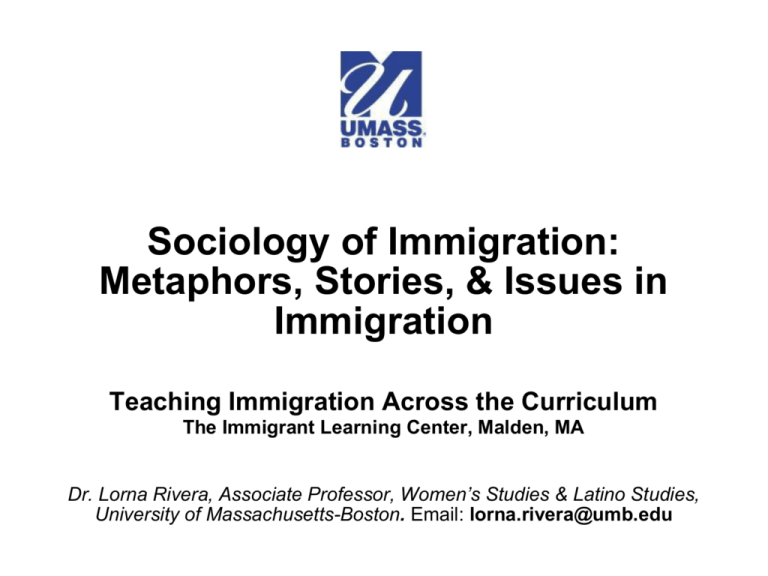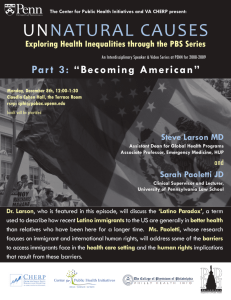Sociology of Immigration - The Immigrant Learning Center
advertisement

Sociology of Immigration: Metaphors, Stories, & Issues in Immigration Teaching Immigration Across the Curriculum The Immigrant Learning Center, Malden, MA Dr. Lorna Rivera, Associate Professor, Women’s Studies & Latino Studies, University of Massachusetts-Boston. Email: lorna.rivera@umb.edu Agenda Introductions & Overview ● Metaphors for Immigration ● Sociology of Immigration ● What factors affect inclusion of immigrants in U.S.? ●Why do some people feel an intense sense of ethnic identity? ●How does a group become a “minority” group? ●Are we living in a “Post-Racial” society? ● U.S. Population In 25 years, 1 out of every 6 Americans will be of Latino ancestry. ● In 25 years, 1 out of every 19 Americans will be of Asian ancestry. ● In 20 years, 1 out of every 4 children in the U.S. public schools will be Latino. ● What factors affect the inclusion of immigrants in the U.S.? --Whether people entered U.S. voluntarily or involuntarily --Racial identification of the group --Size (or perceived numbers) --Cultural Similarities --Timing of the group’s entry Assimilation & Acculturation “Classical” Assimilation theories: Immigrants’ socialization experiences include: Excitement Disenchantment Resolution Relative Deprivation Identification Crisis New Identity Assimilation and Acculturation takes longer if: ●Differences are large between majority and minority group. ●Majority group is not receptive, and minority group retains culture. ●Arrival occurs in relatively short period of time. ●Minority group residents are concentrated, rather than dispersed. ●Recentness of arrival and accessibility of the homeland. What matters? ● ● ● ● Size Power Appearance Discrimination Getting Ahead: Social Mobility, Public Housing, and Immigrant Networks. (2011). By Sylvia Dominguez. New York University Press. ■Latin American women immigrants in East Boston and South Boston use their social networks to become socially mobile. Immigrants are “racialized” in the U.S. ■ Urban poverty research treats Latinos as a “monolithic group and do not take into consideration countries of origin or generation of immigration” (p.14). ■ Immigrant Frames “Latino Paradox” Why are there differences between immigrants and other groups that live in high poverty areas? Why do Latino immigrants do much better on various social indicators than low-income African-Americans and whites? ● Immigrants have “frames that are focused on advancement, social networks that open up opportunities for jobs with potential for advancement, and access to social models that reinforce their agency and drive to get ahead (Dominguez, 2011).” ● “Dual frame of reference” The immigrant narrative “struggle” is a moral discourse that “normalizes aspiration and achievement.” (p. 21). ● For more information: Mauricio Gaston Institute for Latino Public Policy: http://www.gaston.umb.edu Eduardo Bonilla-Silva (2003). Racism Without Racists: Colorblind Racism & Persistence of Racial Inequality in the U.S. Mary Waters (1990) Ethnic Options.











